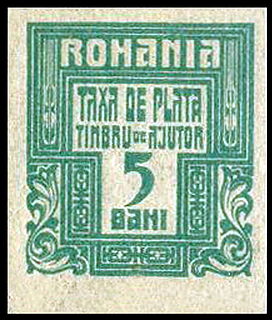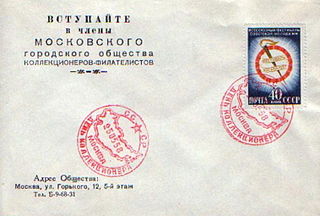This is a survey of the postage stamps and postal history of Transnistria, an unrecognized breakaway territory of Moldova and the de facto independent Pridnestrovian Moldavian Republic.
Soviet Union stamp catalogue is a national catalogue of the RSFSR and USSR postage stamps and miniature sheets, which was being published in the USSR by the “Soyuzpechat” Central Philatelic Agency (CPA) and some other publishers related to the Ministry of Communications. The catalogue usually republished in corpore around once in a 10–15 years. In between republications, additional issues came out every year. These issues contains descriptions of stamps and miniature sheets issued in USSR last year.

The Ministry of Communications of the Union of Soviet Socialist Republics (USSR) was the central state administration body on communications in the Soviet Union from 1923 to 1991. During its existence it had three names: People's Commissariat for Posts and Telegraphs (1923–32), People's Commissariat for Communications (1932–46) and Ministry of Communications (1946–1991). It had authority over the postal, telegraph and telephone communications as well as public radio, technical means of radio and television broadcasting, and the distribution of periodicals in the country.

People's Commissariat for Posts and Telegraphs of the RSFSR, known shortly as the Narkompochtel, was the central organ of government of the RSFSR that was in charge of the organisation and development of the different forms of communication, including postal service. It was founded in Petrograd on 7 November [O.S. 25 October] 1917 from the Russian Ministry of Posts and Telegraphs and retained its organisational structure.

All-Russian Society of Philatelists was the first national philatelic organisation in Soviet Russia established in 1923. Later on, it was subsequently renamed and reorganised into the All-Union Society of Philatelists and the All-Union Society of Collectors.

The First All-Union Philatelic Exhibition was held in Moscow in 1924–1925. Its full name was the First All-Union Philatelic, Scripophilic and Numismatic Exhibition. This was because it combined the objects of philately, scripophily, and numismatics.

In philately, Leniniana is a topic for collecting postage stamps that tell about the life and story of Vladimir Lenin (1870–1924) or people, places, etc. connected with him. The topic was common in the Soviet Union.

War tax due stamp is a kind of war tax and postage due stamps that was used for mail when the war tax has not been paid by the sender. They were issued in Romania between 1915 and 1921.

Filateliya (Philately) or formerly Filateliya SSSR is a Russian central philatelic magazine. It first appeared in 1966 as the monthly bulletin Filateliya SSSR and was issued by the USSR Ministry of Communications. The magazine content includes the history and design of postage stamps, and other related themes.

Kollektsioner or formerly Sovetskii Kollektsioner is a Russian central philatelic yearbook. This annual publication started in 1963 and covered the history and design of postage stamps, and other related topics.

Moscow Municipal Society of Philatelists was a regional philatelic organisation in the Soviet Union established in Moscow in 1957. Later on, it was merged into the All-Union Society of Philatelists.

Moscow Society of Philatelists and Collectors was one of the first philatelic organisations in Soviet Russia that appeared in Moscow in 1918. Later on, it ceased and was replaced with the All-Russian Society of Philatelists.

Moscow Society of Stamp Collectors was one of the first philatelic organisations in the Russian Empire that was created in Moscow in 1883. Later on, it was dissolved and restored in 1907.

Russian Bureau of Philately was a special organisation under the People's Commissariat for Posts and Telegraphs of the RSFSR in 1921–1924. This was the first Soviet government agency in charge of all matters of the organisation and development of philately.

The A.S. Popov Central Museum of Communications is a museum of science and technology founded in 1872. It is located in the historic centre of Saint Petersburg, Russia, near Saint Isaac's Square.

Stamps of the Soviet Union were issued in the period 1923 to 1991. They were labeled with the inscription Russian: "Почта СССР". In the thematics, Soviet stamps reflected to a large extent the history, politics, economics and culture of this world's first socialist state.

The People's Commissariat for Communications of the USSR was the central state agency of the Soviet Union for communications in the period 1932 to 1946. The Commissariat administered the postal, telegraph and telephone services.

Definitive stamps of Russia are the regular postage stamp issues produced in the Russian Empire and RSFSR between 1857 and 1923, and in the Russian Federation since 1992.


















